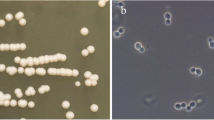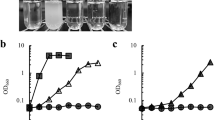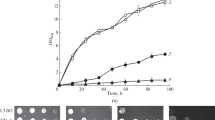Abstract
A Saccharomyces cerevisiae strain in which the GPP1 and GPP2 genes, both encoding glycerol-3-phosphate phosphatase isoforms, are deleted, displays both osmo- and thermosensitive (ts) phenotypes. We isolated genes involved in cell wall maintenance as multicopy suppressors of the gpp1gpp2 ts phenotype. We found that the gpp1gpp2 strain is hypersensitive to cell wall stress such as treatment with β-1,3-glucanase containing cocktail Zymolyase and chitin-binding dye Calcofluor-white (CFW). Sensitivity to Zymolyase was rescued by overexpression of SSD1, while CFW sensitivity was rescued by SSD1, FLO8 and WSC3—genes isolated as multicopy suppressors of the gpp1gpp2 ts phenotype. Some of the isolated suppressor genes (SSD1, FLO8) also rescued the lytic phenotype of slt2 deletion strain. Additionally, the sensitivity to CFW was reduced when the cells were supplied with glycerol. Both growth on glycerol-based medium and overexpression of SSD1, FLO8 or WSC3 had additive suppressing effect on CFW sensitivity of the gpp1gpp2 mutant strain. We also confirmed that the internal glycerol level changed in cells exposed to cell wall perturbation.






Similar content being viewed by others
Abbreviations
- CFW:
-
Calcofluor-white
- FG:
-
Filamentous/invasive growth
- Glycerol-3-P phosphatase:
-
glycerol-3-phosphate phosphatase
- HOG:
-
High osmolarity glycerol
- MAP:
-
Mitogen-activated protein
- PKC:
-
Protein kinase C
- ts:
-
Thermosensitivity
- wt:
-
Wild type
References
Albertyn J, Hohmann S, Thevelein JM, Prior BA (1994) GPD1, which encodes glycerol-3-phosphate dehydrogenase, is essential for growth under osmotic stress in Saccharomyces cerevisiae, and its expression is regulated by the high-osmolarity glycerol response pathway. Mol Cell Biol 14:4135–4144
Alonso-Monge R, Real E, Wojda I, Bebelman JP, Mager WH, Siderius M (2001) Hyperosmotic stress response and regulation of cellular integrity in Saccharomyces cerevisiae share common functional aspects. Mol Microbiol 41:717–730
Angeles de la Torre-Ruiz M, Torres J, Arino J, Herrero E (2002) Sit4 is required for proper modulation of the biological functions mediated by Pkc1 and the cell integrity pathway in Saccharomyces cerevisiae. J Biol Chem 277:33468–33476
Ansell R, Granath K, Hohmann S, Thevelein JM, Adler L (1997) The two isoenzymes for yeast NAD+-dependent glycerol 3-phosphate dehydrogenase encoded by GPD1 and GPD2 have distinct roles in osmoadaptation and redox regulation. EMBO J 16:2179–2187
Bidlingmaier S, Weiss EL, Seidel C, Drubin DG, Snyder M (2001) The Cbk1p pathway is important for polarized cell growth and cell separation in Saccharomyces cerevisiae. Mol Cell Biol 21:2449–2462
Blomberg A (1997) Osmoresponsive proteins and functional assessment strategies in Saccharomyces cerevisiae. Electrophoresis 18:1429–1440
Bonneaud N, Ozier-Kalogeropoulos O, Li GY, Labouesse M, Minvielle-Sebastia L, Lacroute F (1991) A family of low and high copy replicative, integrative and single-stranded S. cerevisiae/E. coli shuttle vectors. Yeast 7:609–615
Boorsma A, de Nobel H, ter Riet B, Bargmann B, Brul S, Hellingwef KJ, Klis FM (2004) Characterization of the transcriptional response to cell wall stress in Saccharomyces cerevisiae. Yeast 21:413–427
Botstein D, Brown PO (2000) Genomic expression programs in the response of yeast cells to environmental changes. Mol Biol Cell 12:4241–4257
Bradford M (1976) A rapid and sensitive method for the quantitation of microgram quantities of protein utilising the principle of protein-dye binding. Anal Biochem 72:248
Causton HC, Ren B, Koh SS, Harbison CT, Kanin E, Jennings EG, Lee TI, True HL, Lander ES, Young RA (2001) Remodeling of yeast genome expression in response to environmental changes. Mol Biol Cell 12:323–337
Cullen PJ, Schultz J, Horecka J, Stevenson BJ, Jigami Y, Sprague GH Jr (2000) Defects in protein glycosylation cause SHO1-dependent activation of a STE12 signaling pathway in yeast. Genetics 155:1005–1018
Davenport KR, Sohaskey M, Kamada Y, Levin DE, Gustin MC (1995) A second osmosensing signal transduction pathway in yeast. J Biol Chem 270:30157–30161
Davenport KR, Williams KE, Ullmann BD, Gustin MC (1999) Activation of the Saccharomyces cerevisiae Filamentation/invasion pathway by osmotic stress in high osmolarity glycerol pathway mutants. Genetics 153:1091–1103
Garcia R, Bermejo C, Grau C, Perez R, Rodriguez-Pena JM, Francois J, Nombela C, Arroyo J (2004) The global transcriptional response to transient cell wall damage in Saccharomyces cerevisiae and its regulation by the cell integrity signaling pathway. J Biol Chem 279:15183–15195
Garcia-Rodrigues LJ, Duran A, Roncero C (2000) Calcofluor antifungial depends on chitin and a functional high-osmolarity glycerol response (HOG) pathway: evidence for a physiological role of the Saccharomyces cerevisiae HOG pathway under noninducing conditions. J Bacteriol 182:2428–2437
Gasch P, Spellman PT, Kao CM, Carmel-Harel O, Eisen MB, Storz G, Botstein D, Brown PO (2000) Genomic expression programs in the response of yeast cells to environmental changes. Mol Biol Cell 12:4241–4257
Gietz D, St Jean A, Woods RA, Schiestl RH (1992) Improved method for high efficiency transformation of intact yeast cells. Nucleic Acids Res 20:1425
Gomes KN, Freitas SM, Pais TM, Fietto JL, Totola AH, Arantes RM, Martins A, Lucas C, Schuller D, Casal M, Castro IM, Fietto LG, Brandao RL (2005) Deficiency of Pkc1 activity affects glycerol metabolism in Saccharomyces cerevisiae. FEMS Yeast Res 5:767–776
Gustin MC, Albertyn J, Alexander M, Davenport K (1998) MAP kinase pathways in the yeast Saccharomyces cerevisiae. Microbiol Mol Biol Rev 62:1264–1300
Heinisch JJ, Lorberg A, Schmitz H-P, Jacoby JJ (1999) The protein kinase C-mediated MAP kinase pathway involved in the maintenance of cellular integrity in Saccharomyces cerevisiae. Mol Microbiol 32:671–680
Hohmann S (2002) Osmotic stress signaling and osmoadaptation in yeast. Microbiol Mol Biol Rev 66:300–372
Hohmann S, Mager WH (1997) Yeast stress responses. Springer-Verlag, Heidelberg, Germany
Igual JC, Johnson AL, Johnson LH (1996) Coordinated regulation of gene expression by the cell-cycle transcription factor Swi4 and the protein kinase C MAP kinase for yeast cell integrity. EMBO J 15:5001–5013
Jorgensen P, Nelson B, Robinson MD, Chen Y, Andrews B, Tyers M, Boone C (2002) High-resolution genetic mapping with ordered arrays of Saccharomyces cerevisiae deletion mutants. Genetics 162:1091–1099
Kaeberlein M, Guarente L (2002) Saccharomyces cerevisiae MPT5 and SSD1 function in parallel pathways to promote cell wall integrity. Genetics 160:83–95
Kamada Y, Jung US, Piotrowski J, Levin DE (1995) The protein kinase C-activated MAP kinase pathway of Saccharomyces cerevisiae mediates a novel aspect of the heat shock response. Genes Dev 9:1559–1571
Kapteyn JC, ter-Riet B, Vink E, Blad S, De Nobel H, Van Den Ende H, Klis FM (2001) Low external pH induces HOG-1 dependent changes in the organization of the Saccharomyces cerevisiae cell wall. Mol Microbiol 39:469–479
King L, Butler G (1998) Ace2, a regulator of CTS1 (chitinase) expression, affects pseudochyphal production in Saccharomyces cerevisiae. Curr Genet 34:183–191
Klebe RJ, Harriss JV, Sharp ZD, Douglas MG (1983) A general method for polyethylene-glycol-induced genetic transformation of bacteria and yeast. Gene 25:333–341
Kobayashi O, Suda H, Ohtani T, Sone H (1996) Molecular cloning and analysis of the dominant flocculation gene FLO8 from Saccharomyces cerevisiae. Mol Gen Genet 251:707–715
Lages F, Lucas C (1997) Contribution to the physiological characterization of glycerol active uptake in Saccharomyces cerevisiae. Biochim Biophys Acta 1322:8–18
Lee BN, Elion EA (1999) The MAPKKK Ste11 regulates vegetative growth through a kinase cascade of shared signaling components. Proc Natl Acad Sci USA 96:12679–12684
Lee KS, Levin DE (1992) Dominant mutations in a gene encoding a putative protein kinase (BCK1) bypass the requirement for Saccharomyces crevisiae protein kinase C homolog. Mol Cell Biol 12:172–182
Liu H, Styles CA, Fink GR (1996) Saccharomyces cerevisiae S288C has a mutation in FLO8, a gene required for filamentous growth. Genetics 144:967–978
Madden K, Sheu YJ, Baetz K, Andrews B, Snyder M (1997) SBF cell cycle regulator as a target of the yeast PKC-MAP kinase pathway. Science 275:1781–1784
Martin H, Castellanos MC, Cenamor R, Sanchez M, Molina M, Nombela C (1996) Molecular and functional characterization of a mutant allele of the mitogen-activated protein-kinase gene SLT2 (MPK1) rescued from yeast autolytic mutants. Curr Genet 29:516–522
Martin H, Rodriques-Pachon JM, Ruiz C, Nombela C, Molina M (2000) Regulatory mechanisms for modulation of signaling through the cell integrity Slt2p-mediated pathway in Saccharomyces cerevisiae. J Biol Chem 275:1511–1519
de Nadal E, Casadome L, Posas F (2003) Targeting the MEF2-like transcription factor Smp1 by the stress-activated Hog1 mitogen-activated protein kinase. Mol Cell Biol 23:229–237
de Nobel H, Ruiz C, Martin H, Morris W, Brul S, Molina M, Klis FM (2000) Cell wall perturbation in yeast results in dual phosphorylation of the Slt2/Mpk1 MAP kinase and in an SLT2-mediated increase in FKS2-LacZ expression, glucanase resistance and thermotolerance. Microbiology 146:2121–2132
O’Rourke SM, Herskowitz I (2002) A third osmosensing branch in Saccharomyces cerevisiae requires the Msb2 protein and functions in parallel with the Sho1 branch. Mol Cell Biol 22:4739–4749
Pahlman AK, Granath K, Ansell R, Hohmann S, Adler L (2001) The yeast glycerol-3 phosphatases Gpp1p and Gpp2p are required for glycerol biosynthesis and differentially involved in the cellular responses to osmotic, anaerobic, and oxidative stress. J Biol Chem 276:3555–3563
Philip B, Levin DE (2001) Wsc1 and Mid2 are cell surface sensors for cell integrity signaling that act through Rom2, a guanine nucleotide exchange factor for Rho. Mol Cell Biol 21:271–280
Posas F, Takekawa M, Saito H (1998) Signal transduction by MAP kinase cascades in budding yeast. Curr Opin Microbiol 1:175–182
Racki WJ, Becam AM, Nasr F, Herbert CJ (2000) Cbk1p, a protein similar to the human myotonic dystrophy kinase, is essential for normal morphogenesis in Saccharomyces cerevisiae. EMBO J 19:4524–4532
Reinke A, Anderson S, McCaffery JM, Yates J III, Aronova S, Chu S, Fairclough S, Iverson C, Wedaman KP, Powers T (2004) TOR complex 1 includes novel component, Tco89p (YPL180w), and cooperates with Ssd1p to maintain cellular integrity in Saccharomyces cerevisiae. J Biol Chem 279:14752–14762
Reinoso-Martin C, Schuller C, Schuetzer-Muehlbauer M, Kuchler K (2003) The yeast protein kinase C cell integrity pathway mediates tolerance to the antifungal drug caspofungin through activation of Slt2p mitogen-activated protein kinase signaling. Eukaryot Cell 2:1200–1210
Rupp S, Summers E, Lo HJ, Madhani H, Fink G (1999) MAP kinase and cAMP filamentation signaling pathways converge on the unusualy large promoter of the yeast FLO11 gene. EMBO J 18:1257–1269
Salgado APC, Schuller D, Casal M, Leao C, Fietto LG, Tropia MJM, Castro IM, Brandao RL (2002) Relationship between protein kinase C and derepression of different glucose-controlled enzymes. FEBS Lett 532:324–332
Siderius M, Mager WH (2003) Conditional response to stress in yeast. Monatsh Chem 134:1433–1444
Siderius M, Van Wuytswinkel O, Reijenga KA, Kelders M, Mager WH (2000) The control of intracellular glycerol in Saccharomyces cerevisiae influences osmotic stress response and resistance to increased temperature. Mol Microbiol 36:1381–1390
Sutton A, Immanuel D, Arndt KT (1991) The Sit4 protein phosphatase functions in late G1 for progression into S phase. Mol Cell Biol 11:2133–2148
Turchini A, Ferrario L, Popolo L (2000) Increase of external osmolarity reduces morphogenetic defects and accumulation of chitin in a gas1 mutant of Saccharomyces cerevisiae. J Bacteriol 182:1167–1171
Verna J, Lodder A, Lee K, Vagts A, Ballester R (1997) A family of genes required for maintenance of cell wall integrity and for the stress response in Saccharomyces cerevisiae. Proc Natl Acad Sci USA 94:13804–13809
Versele M, Thevelein JM (2001) Lre1 affects chitinase expression, trehalose accumulation and heat resistance through inhibition of the Cbk1 protein kinase in Saccharomyces cerevisiae. Mol Microbiol 41:1311–1326
Wojda I, Alonso-Monge R, Bebelman JP, Mager WH, Siderius M (2003) Response to high osmotic conditions and elevated temperature in Saccharomyces cerevisiae is controlled by intracellular glycerol and involves coordinate activity of MAP kinase pathways. Microbiology 149:1193–1204
Ackowledgements
We are indebted to Dr Piet de Groot (Swammerdam Institute for Life Sciences, University of Amsterdam) for guidance in the initial analyses of the cell wall composition.
Author information
Authors and Affiliations
Corresponding author
Rights and permissions
About this article
Cite this article
Wojda, I., Bebelman, JP., Jakubowicz, T. et al. Thermosensitivity of the Saccharomyces cerevisiae gpp1gpp2 double deletion strain can be reduced by overexpression of genes involved in cell wall maintenance. Arch Microbiol 188, 175–184 (2007). https://doi.org/10.1007/s00203-007-0234-9
Received:
Revised:
Accepted:
Published:
Issue Date:
DOI: https://doi.org/10.1007/s00203-007-0234-9




